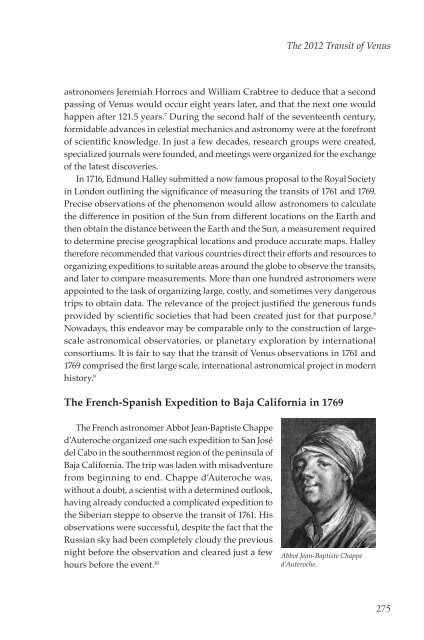Complete Issue Online - San Diego History Center
Complete Issue Online - San Diego History Center
Complete Issue Online - San Diego History Center
You also want an ePaper? Increase the reach of your titles
YUMPU automatically turns print PDFs into web optimized ePapers that Google loves.
The 2012 Transit of Venus<br />
astronomers Jeremiah Horrocs and William Crabtree to deduce that a second<br />
passing of Venus would occur eight years later, and that the next one would<br />
happen after 121.5 years. 7 During the second half of the seventeenth century,<br />
formidable advances in celestial mechanics and astronomy were at the forefront<br />
of scientific knowledge. In just a few decades, research groups were created,<br />
specialized journals were founded, and meetings were organized for the exchange<br />
of the latest discoveries.<br />
In 1716, Edmund Halley submitted a now famous proposal to the Royal Society<br />
in London outlining the significance of measuring the transits of 1761 and 1769.<br />
Precise observations of the phenomenon would allow astronomers to calculate<br />
the difference in position of the Sun from different locations on the Earth and<br />
then obtain the distance between the Earth and the Sun, a measurement required<br />
to determine precise geographical locations and produce accurate maps. Halley<br />
therefore recommended that various countries direct their efforts and resources to<br />
organizing expeditions to suitable areas around the globe to observe the transits,<br />
and later to compare measurements. More than one hundred astronomers were<br />
appointed to the task of organizing large, costly, and sometimes very dangerous<br />
trips to obtain data. The relevance of the project justified the generous funds<br />
provided by scientific societies that had been created just for that purpose. 8<br />
Nowadays, this endeavor may be comparable only to the construction of largescale<br />
astronomical observatories, or planetary exploration by international<br />
consortiums. It is fair to say that the transit of Venus observations in 1761 and<br />
1769 comprised the first large scale, international astronomical project in modern<br />
history. 9<br />
The French-Spanish Expedition to Baja California in 1769<br />
The French astronomer Abbot Jean-Baptiste Chappe<br />
d’Auteroche organized one such expedition to <strong>San</strong> José<br />
del Cabo in the southernmost region of the peninsula of<br />
Baja California. The trip was laden with misadventure<br />
from beginning to end. Chappe d’Auteroche was,<br />
without a doubt, a scientist with a determined outlook,<br />
having already conducted a complicated expedition to<br />
the Siberian steppe to observe the transit of 1761. His<br />
observations were successful, despite the fact that the<br />
Russian sky had been completely cloudy the previous<br />
night before the observation and cleared just a few<br />
hours before the event. 10<br />
Abbot Jean-Baptiste Chappe<br />
d’Auteroche.<br />
275







![[PDF] The Journal of San Diego History Vol 52: Nos 1 & 2](https://img.yumpu.com/25984149/1/172x260/pdf-the-journal-of-san-diego-history-vol-52-nos-1-2.jpg?quality=85)

![[PDF] The Journal of San Diego History - San Diego History Center](https://img.yumpu.com/25984131/1/172x260/pdf-the-journal-of-san-diego-history-san-diego-history-center.jpg?quality=85)







